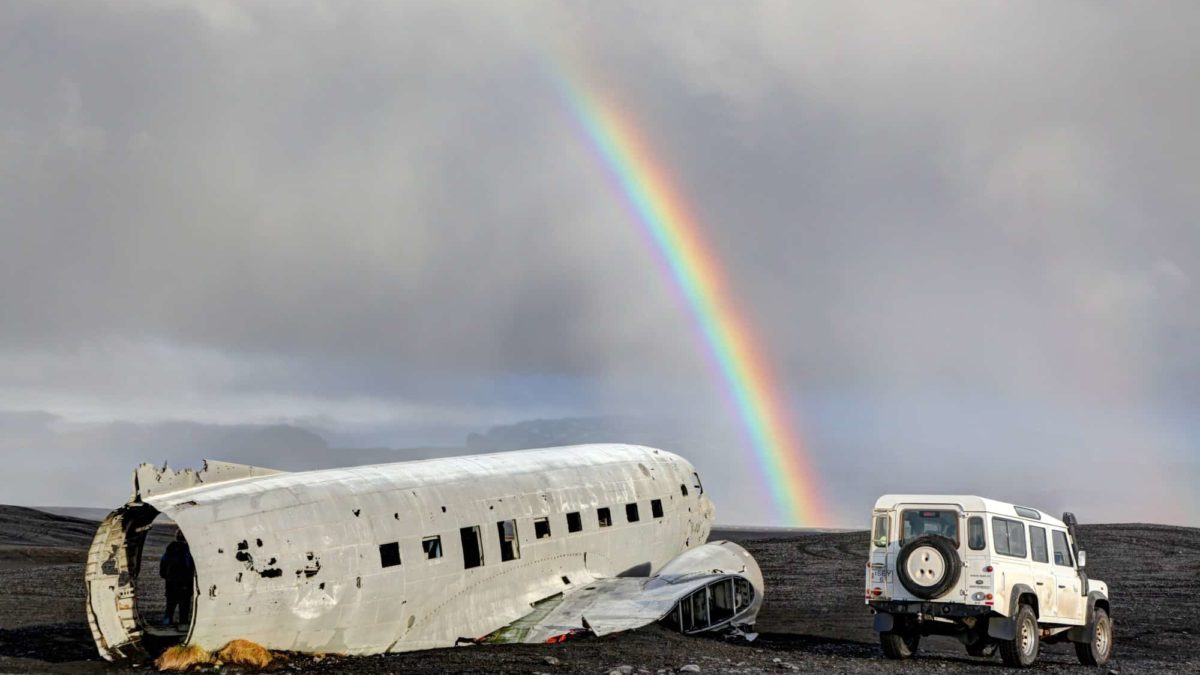Free and exclusive discount codes for hundreds of tours and & travel services in Iceland
Subscribe to instantly receive discount codes for tours, car rental, camper van rental, and outdoor clothing rental. Thank you! ❤️ Jon Heidar, Editor of Stuck in Iceland Travel MagazineWords and pictures are by Malcolm Holmes. He lives in Milton Keynes, England and is a design manager for a major Japanese car manufacturer. He has been obsessed by travel and photography since his teenage years. As his son has grown up, they have spent many enjoyable school holidays exploring more and more of Iceland together. In the winter of 2014 he went on a epic Iceland Land Rover Defender Road Trip.
Six trips around Iceland – this time in a Land Rover Defender
‘Surely after 6 trips you have seen enough of Iceland?’ a friend asked us just before left for our seventh visit . The answer was of course a blunt ‘no’. Our seventh trip was going to be taking us ‘full circle’, basically following route 1, but with ‘diversions’ to some of the places off the beaten track that we have grown to love during our visits over the last four years, and a few new locations that we had yet to discover.

Heading to the pool
We arrived as the black of night closed in. A thin mist was forming in the air, and it was distinctly colder as we unloaded or bags and bundle into the Borgarnes Hostel. We paused in the hostel only briefly to chat with the friendly, enthusiastic staff and retrieve our swimming gear from the bags, then headed to the pool.

Getting the Iceland Land Rover Defender Road Trip off to a great start
Anyone who has visited Iceland will know the nations love of swimming pools. Just about every town, village, and even small settlements has a pool. Geothermal heat overcomes the prohibitive operating costs that make them so expensive at home in the UK, and allows Icelandic communities to create a warm oasis where they can exercise, socialize and relax together in super warm pools and hot pots. Borgarnes pool is one of my favourites. Three steaming hot pots, a great multi lane 25m pool, kids slides and splash pools (all outside of course), and a smaller indoor pool. As I sat in the hot pot, the mist played over the pool and the underwater lights seemed to create their own blue aurora playing above the water surface. The outside temperature was -1C and the water temperature 39C. Suitably relaxed and warmed to the core. The trip was off to a good start.
Going to Djupavik in the Westfjords
In the morning, we leave the hostel as the sky starts to brighten. Thick mist hangs in the air and the Land Rover Defender Isey has a crusty coating of frost on the windows. How nice to have heated seats and a heated windscreen on! We leave Borgarnes behind and continue north. Destination today is Djupavik. Population four, plus a dog called Freya.

Arriving at the extreme of the Westfjords
Djupavik lies at the end of Reykjarfjordur, about 70km north of Holmavik on the eastern extreme of the Western Fjords. In 1935 a group of businessmen began the construction of what was at the time, the largest concrete structure in Europe. A fish processing factory on a scale never seen before. Operation started in 1936 and the plentiful supply of mackerel assured shipping boats arrived, dozens a day fully loaded, to feed the outrageous appetite of the factory. Three colossal fish oil tanks filled with the liquid gold harvested from the sea, and thousands of bags of fish meal left the factory every week, ensuring that the owners, and the small settlement at Djupavik, prospered.

Within a decade though the fish stocks were dwindling and despite diversification, the Djupavik plant closed down for good in 1954. A huge concrete monument to an unsustainable industry.

The second life of Djupavik
The rusting hull of ‘MS Sudurland’, the 95 year old coaster that served the factory as accommodation for some of the workers, remains at the end of the fjord today. In 1985 the factory and the female workers boarding house nearby were bought by Eva & Asi. The boarding house became Hotel Djupavik and the fish factory became both a museum and an art gallery. Djupavik found a second life.
Watch a documentary about the fish processing plant in Djupavik
Driving the remote Strandir
We left the tarmacked road shortly after Holmavik, and joined route F643, a pot holed graded track heading north to Djupavik, and ultimately, 100km to the small cluster of farms buildings that is Krossnes. A few cm of snow lay on the track as we climbed over the pass from Bassastadir to Odi and then dropped back down to the sea at Bjarnafjordur. From there the track hugs the Strandir coast, winding around breath-taking headlands and into beautifully barren fjords. Occasionally seals can be seen bobbing up from the waves breaking along the cost. Vast piles of driftwood, driven by the tides from Siberia, lay washed high up onto the beaches. Roots and branches, well weathered by years in the north Atlantic, worn into contoured shapes that would be admired by anyone trying to create a retro 70’s look in their living room.
Delicate crossings
Eventually the track takes a shortcut, and ascends bravely over a rock fall strewn pass, a mountain, named Kambur, blocking the alternative route around the headland. The snow gets gradually thicker, and we alternate between heavy snow fall and bright blue sky. The camber on the track leans Isey towards the edge of the tack and the long drop beyond. Gentle second gear, diff lock engaged, don’t slip. We edge over the summit and start dropping down towards the sea once again, Djupavik only a few km away.
Exploring the shoreline
After arriving at Hotel Djupavik and depositing our bags we head out to explore the shoreline and the area around the factory. Gulls sit motionless on the remains of the landing jetty, about 50m away from shore. There are breaks in the cloud and pale late afternoon sun shines reflects strongly from the snow covered mountains on the opposite side of the fjord. We will be passing that way tomorrow, but for now I just enjoy the calm and take in the wonderful view. My son Ellis, and nephew Alex, are enjoying a snow ball fight, and Freya the dog is joining in too. Few of the snowballs hit their target since Freya is far too quick to intercept their path and bite them mid-flight. All three of them enjoy the game until hands (and canine mouths) are too cold.
Unusual concert hall
On the far side of the factory are the three colossal fish oil tanks. Huge echoing caverns. Ellis slides himself through the porthole like access hatch and spends a good time enjoying the echoing ambiance within. Sigur Ros held a concert in this tank back in 2006 as part of their uniquely low key tour of Iceland. Watch their beautifully produced movie of the tour, ‘Heima’ and you will understand what a unique and atmospheric location Djupavik is.
Dream view
Long after the last sunlight has disappeared from the sky, we venture out of the hotel once again. The chill of the night surrounds us. Its -5degrees now, but its calm, there is no wind, and the sky is partially clear. As our eyes adjust we see the sky is green. We walk a few hundred meters away from the hotel, away from the lights, and then it becomes clear. The aurora borealis is trying to give us a show. The remaining clouds partially defuse the light but despite that we feel so lucky to enjoy the spectacle that every visitor to Iceland longs to see.
Climbing to the village of Gjogur
Our third day starts before the sun is up. Isey takes us further north along the slippery track that follows the edge of the fjord before climbing up to the village of Gjogur. The population of Gjogur can’t be more than 30 and yet it has its own airport. The airport is one of only a few in the world without a paved runway and yet has scheduled flights. In this case, a weekly flight to Reykjavik.
In deep snow
We take a turn at the tiny settlement of Melar onto the F649 and start climbing over another mountain pass, deep in snow and with no other tyre tracks. If it was not for the yellow posts marking the way we really would have no idea where to drive. As we climb towards the summit of the pass, the snow is getting really deep. I can feel the Isey’s axels dragging in the soft fresh snow. We reach the top, and then it’s a steep descent through multiple switch backs before eventually descending below the snow line, and into the once prosperous settlement of Ingolfsfjordur.

In remote Ingolfsfjordur
Like Djupavik, Ingolfsfjordur was built on the mackerel trade. Another abandoned and dilapidated fish factory, a couple of smart but seemingly unoccupied houses and the partially dilapidated accommodation building are all that remain. This place seems even more haunting than Djupavik. For Ingolfsjordur there really has been no salvation. No one with the vision to create a new beginning. No one able to open up the beauty of the surrounds or the amazing modern history to visitors. The fish went and so did everything else, or so it would seem.

We stop for photographs only for a short time before turning back and aiming Isey 6 towards Krossnes, at the end of the track north, where we know there will be a far more inviting treat waiting for us.

At 66 degrees north
Krossnes is pretty much as far north as you can get on the east coast of the Westfjords. Its 66 Degrees North and as the famous Icelandic clothing brand is always keen to remind you, its wild, rugged and remote at this latitude. What is not always so well publicized is that there is the most wonderful swimming pool in Iceland (official results of the survey of three of us on this trip) is located on the beach, just beyond the last farm house that is Krossnes.

The most amazing pool ever!
The pool was built in 1954, and the natural hot spring that feeds it has kept it at a mid 30’sC ever since. It surprises the visitor in so many ways. It’s so clean, its so warm, its on a beach, there’s no electricity, no lights, but there are candles. There’s no one else there and just why did anyone build a pool in such a remote location? I’m not to sure on how or why, but I can say that this most amazing pool I have ever visited, filled by the second oldest water in the world (only out-aged by a hot spring in Hawaii apparently), it is one of my favorite places in the world. Visiting for the first time in 2013 was a kind of epiphany. I adore this place.

Inside the cathredal
Back in Djupavik in the late afternoon we ask Eva to show us the inside of the old factory, Even after nearly 30 years since they took on the factory, the preservation remains very much ‘work in progress’. Even this year Eva, Asi and a team of volunteers that help out in the summer months, have discovered previously hidden spaces behind walls previously thought to be solid concrete. Every wall of the plant has a deep patina, organic colours, cracks and textures that provide a gothic canvas on which to present the art that adorns the walls every summer. The machine rooms are ghostly reminders of the intense industry that inhabited this quite fjord all those years ago. Much of the machinery remains. Huge engines, generators, chutes and ovens. Workers signatures and messages and tallies from the 1940s engraved into the wooden chutes add a human dimension that pulls your imagination back 70 years and fills the mind with even more questions. Cathedral like windows allow the majesty of the surrounding mountains to connect with the history preserved within. What an amazing view to close the day with.

Going to to the north east
In the coming days Isey takes us to Akureyri, the capital of the north, underground hot springs near Myvatn, beautiful Seydisfjordur, Hofn, the ice-fingers projecting from Vatnajokul, the black beach at Vik and many more locations that will remain permanently engraved in our memories.

Our trip ends with just one night in Reykjavik. Over an Italian meal we discuss our favourite locations, but its impossible to choose. I don’t want to choose, I love it all. I guess we will just have to come back again next year and try and figure it out then.

Now its late November. I have a map in front of me. I have never been to Isafjordur, yet the fish we enjoyed for dinner last Friday came from there. Just a few hours away and a short ferry ride is the island of Flatey I remember seeing the island in the dark comedy film ‘White Nights Wedding’.
I can see our 8th trip starting to take shape.
More photos from the Iceland Land Rover Defender road trip











